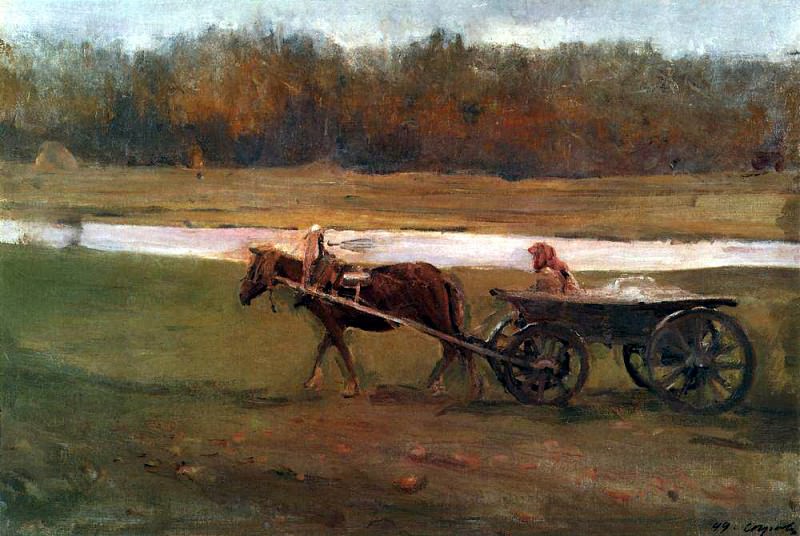Baba in the cart. 1896 Valentin Serov (1865-1911)
Valentin Serov – Baba in the cart. 1896
Edit attribution
Download full size: 1000×669 px (0,1 Mb)
Painter: Valentin Serov
1896; canvas, oil; 48x70; Russian Museum. "Baba in a Cart" is by no means the most famous painting of the great Russian painter, undeservedly forgotten and neglected. Perhaps the chosen subject and the somewhat monotonous palette make it less memorable compared to other masterpieces by Serov, but it is by no means as simple and unambiguous as it might seem at first glance. The foreground depicts the painting’s protagonists - a wiry old horse, walking heavily under a yoke, and a woman in a kerchief riding in a cart.
Description of Valentin Serov’s painting "Woman in a cart".
1896; canvas, oil; 48x70; Russian Museum.
"Baba in a Cart" is by no means the most famous painting of the great Russian painter, undeservedly forgotten and neglected. Perhaps the chosen subject and the somewhat monotonous palette make it less memorable compared to other masterpieces by Serov, but it is by no means as simple and unambiguous as it might seem at first glance.
The foreground depicts the painting’s protagonists - a wiry old horse, walking heavily under a yoke, and a woman in a kerchief riding in a cart. All around them there is a familiar landscape of typical Central Russian nature: deciduous forest in the background is just touched by the crimson colors of autumn, a small river cuts the plain in two, you can see a heap of compressed straw. The colors are chosen most restrained, dim and inexpressive, as if to strongly emphasize the commonness and typicality of the subject, its dull routine.
Both the horse, walking obediently to its stable, and the woman chasing it to the house, it seems, barely notice what is happening around them. You could say that the characters in the painting are immersed in their own thoughts, but fatigue doesn’t give them time to think. The dullness of daily work, repeated time after time, drives the heroes of the painting into the same sleepy, melancholic stupor that grips the attentive viewer.
The hopelessness, the simplicity of life and the inevitability of the impending end are reflected in this simple yet evocative subject. The painting is one of Serov’s most beloved and valued, and he always fiercely defended its value. According to the author, through his creation he wanted to convey a general universal thoughtfulness inherent in both man endowed with reason and nature as a whole, in all its manifestations: in living creatures, plants, even in the heavens and the earth around us.
Кому понравилось
Пожалуйста, подождите
На эту операцию может потребоваться несколько секунд.
Информация появится в новом окне,
если открытие новых окон не запрещено в настройках вашего браузера.
You need to login
Для работы с коллекциями – пожалуйста, войдите в аккаунт (open in new window).




















You cannot comment Why?
The painting depicts a rural scene with a horse-drawn cart traversing a field. The horse is in motion, with its gait suggesting a steady pull. The cart, a simple wooden structure, carries a person, likely female given the title Baba (which means old woman or peasant woman in Russian), and what appears to be hay or some other farm produce. The background features a distinct line of trees, rendered with a looser, impressionistic style, and a body of water, possibly a river or a stream, separating the foreground field from the distant tree line. The sky is overcast, contributing to a somewhat somber or perhaps tranquil mood, depending on interpretation.
The subtexts of the painting can be interpreted in several ways: